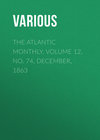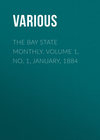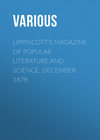Kitabı oku: «The Atlantic Monthly, Volume 12, No. 74, December, 1863», sayfa 10
The pulpit is but a sympathetic deceiver, when it violates the truth it is set to defend. All its lies are echoes of the avarice and inhumanity sitting in the pews; and when, in the rough old figure, it is a dumb dog that will not bark at the robber or warn us of danger, the real mutes, whom its silence but copies, are those demure men below who seem to listen to its instructions.
We are astonished to find a liar in the lightning of heaven over the telegraphic wires. Let us get over our surprise. The lie is human altogether, not elemental at all. The operator has his private object to carry, the partisan his political end to serve, the government itself flatters the people it fears with incorrect accounts of military movements and fortified posts and the numbers of dead and wounded on either side. Kinglake calls the telegraph a device by which a clerk dictates to a nation. Who but the nation, or some part of it, dictates to the clerk? He does not control, but records, the sentiment of the community in all his invented facts; and when we hear the click or read the strange dots, we want some trustworthy voucher or responsible human auditor even of these electric accounts.
But, creatures of sympathy, needy dependants on approbation, as we are, shall we surrender to all or any of these lies? No,—there is a sympathy of truth, to whose higher court and supreme verdict we must appeal. Before it let us stand ourselves, perpetual witnesses of the very truth of God in our breast. Said the lion-hearted Andrew Jackson, "When I decide on my course, I do not ask what people will think, but look into my own heart for guidance, believing that all brave men will agree with me."
"As the minister began on the subject of Slavery, I left the church," said a respectable citizen to a modest woman, of whose consent with him he felt sure.
"And did the minister go on?" she gently inquired.
"Yes, he went on," the mistaken citizen replied.
So, in this land, let us go on in the way of justice and truth we have at last begun. Let us have no more sympathetic, however once legal, lies for oppression and wrong. We shall be as good as a thousand years old, when we are through our struggle. For the respect of Europe let us have no anxiety. It will come cordially or by constraint, upon the victory of the right and the reinstating of our manhood by the divine law, to the discouragement of all iniquity at home or abroad. Our success will be a signal for all the tyrannies, in which the proud and strong have been falsely banded together to crush the ignorant and lowly, to come down. The domineering political and ecclesiastical usurpers of exclusive privilege will no longer give and take reciprocal support against the rising of mankind than the Roman augurs could at last keep one another in countenance. Let us go on, through dark omens as well as bright, and suffer ourselves to have no doubting day. Let us show that something besides a monarchy in this world can stand. On disbelievers and obstructers let us have companion. They cannot live contented, and it is not quite safe for them to die. The path of our progress opens clear. Let us not admit the idea of failure. To think of failing is to fail. As it was with the sick before their Saviour of old, only our faith can make us whole.
SOMETHING ABOUT BRIDGES
Instinctively, Treason, in this vast land, aimed its first blow at the Genius of Communication,—the benign and potent means and method of American civilization and nationality. The great problem Watt and Fulton, Clinton and Morse so gloriously solved, a barbaric necessity thus reduces back to chaos; and not the least sad and significant of the bulletins whereby the most base of civic mutinies finds current record is that entitled, "Destruction of the Bridges"; and (melancholy contrast!) simultaneously we hear of constructive energy in the same direction, on the Italian peninsula,—an engineer having submitted to Victor Emmanuel proposals for throwing a bridge across the Straits of Messina, "binding Scylla to Charybdis, and thus clinching Italian unity with bonds of iron." Bonds of nationality, in more than a physical sense, indeed, are bridges: even cynical Heine found an endeared outlook to his native Rhine on the bastion of a familiar bridge; Tennyson makes one an essential feature of his English summer picture, wherein forever glows the sweet image of the "Gardener's Daughter"; and Bunyan found no better similitude for Christian's passage from Time to Eternity than the "river where there is no bridge."
The primitive need, the possible genius, the science, and the sentiment of a bridge endear its aspect and associations beyond those of any other economical structure. There is, indeed, something genially picturesque about a mill, as Constable's pencil and Tennyson's muse have aptly demonstrated; there is an artistic miracle possible in a sculptured gate, as those of Ghiberti so elaborately evidence; science, poetry, and human enterprise consecrate a light-house; sacred feelings hallow a spire; and mediæval towers stand forth in noble relief against the sunset sky: but around none of these familiar objects cluster the same thoroughly human associations which make a bridge attractive to the sight and memory. In its most remote suggestion it typifies man's primal relation to Nature, his first instinctive effort to circumvent or avail himself of her resources; indeed, he might take his hint of a bridge from Nature herself,—her fallen monarchs of the forest athwart a stream, "the testimony of the rocks," the curving shores, cavern roofs, and pendent branches, and the prismatic bow in the heavens, which a poet well calls "a bridge to tempt the angels down."
A bridge of the simplest kind is often charmingly effective as a landscape-accessory: there is a short plank one in a glen of the White Mountains, which, seen through a vista of woodland, makes out the picture so aptly that it is sketched by every artist who haunts the region. What lines of grace are added to the night view of a great city by the lights on the bridges! what subtile principles enter into the building of such a bridge as the Britannia, where even the metallic contraction of the enormous tubes is provided for by supporting them on cannon-balls! how venerable seems the most graceful of Tuscan bridges, when we remember it was erected in the fifteenth century,—and the Rialto, when we think that it was designed by Michel Angelo! and how signal an instance is it of the progressive application of a true principle in science, that the contrivance whereby the South-Americans bridge the gorges of their mountains, by a pendulous causeway of twisted osiers and bamboo,—one of which, crossed by Humboldt, was a hundred and twenty feet long,—is identical with that which sustains the magnificent structure over the Niagara River! In a bridge the arch is triumphal, both for practical and commemorative ends: unknown to the Greeks and Egyptians, even the ancient Romans, it is said by modern architects, did not appreciate its true mechanical principle, but ascribed the marvellous strength thereof to the cement which kept intact their semicircle. In Cæsar's "Commentaries," the bridge transit and vigilance form no small part of military tactics,—boats and baskets serving the same purpose in ancient and modern warfare. The Church of old originated and consecrated bridges; religion, royalty, and art celebrate their advent; the opening of Waterloo Bridge is the subject of one of the best pictures of a modern English painter; and Cockney visitors to the peerless Bridge of Telford still ask the guide where the Queen stood at its inauguration. But it is when we turn from the historical and scientific to the familiar and personal that we realize the spontaneous interest attached to a bridge. It is as a feature of our native landscape, the goal of habitual excursions, the rendezvous, the observatory, the favorite haunt or transit, that it wins the gaze and the heart. There the musing angler sits content; there the echoes of the horse's hoofs rouse to expectancy the dozing traveller; there the glad lover dreams, and the despairing wretch seeks a watery grave, and the song of the poet finds a response in the universal heart,—
"How often, oh, how often,
In the days that have gone by,
Have I stood on that bridge at midnight,
And gazed on the wave and sky!"
One of the most primitive tokens of civilization is a bridge; and yet no artificial object is more picturesquely associated with its ultimate symbols: the fallen tree whereon the pioneer crosses a stream in the wilderness is not more significant of human isolation than the fragmentary arch in an ancient city of the vanished homo of thousands. Thus, by its necessity and its survival, a bridge suggests the first exigency and the last relic of civilized life. The old explorers of our Western Continent record the savage expedients whereby water-courses were passed,—coils of grape-vine carried between the teeth of an aboriginal swimmer and attached to the opposite bank, a floating log, or, in shallow streams, a series of stepping-stones; and the most popular historian of England, when delineating to the eye of fancy the hour of her capital's venerable decay, can find no more impressive illustration than to make a broken arch of London Bridge the observatory of the speculative reminiscent.
The bridge is, accordingly, of all economical inventions, that which is most inevitable to humanity, signalizing the first steps of man amid the solitude of Nature, and accompanying his progress through every stage of civic life: its crude form makes the wanderer's heart beat in the lonely forest, as a sign of the vicinity or the track of his kind; and its massive remains excite the reverent curiosity of the archæologist, who seeks among the ruins of Art for trophies of a by-gone race. Few indications of Roman supremacy are more striking than the unexpected sight of one of those bridges of solid and symmetrical masonry which the traveller in Italy encounters, when emerging from a mountain-pass or a squalid town upon the ancient highway. The permanent method herein apparent suggests an energetic and pervasive race whose constructive instinct was imperial; such an evidence of their pathway over water is as suggestive of national power as the evanescent trail of the savage is of his casual domain. In the bridge, as in no other structure, use combines with beauty by an instinctive law; and the stone arch, more or less elaborate in detail, is as essential now to the function and the grace of a bridge as when it was first thrown, invincible and harmonious, athwart the rivers Cæsar's legions crossed.
As I stood on the scattered planks which afford a precarious foothold amid the rapids of St. Anthony, methought these frail bridges of hewn timber accorded with the reminiscence of the missionary pioneer who discovered and named the picturesque waters more than an elaborate and ancient causeway. Even those long, inelegant structures which lead the pedestrian over our own Charles River, or the broad inlets of the adjacent bay, have their peculiar charm as the scene of many a gorgeous autumnal sunset and many a patient "constitutional" walk. It is a homely, but significant proverb, "Never find fault with the bridge that carries you safe over." What beautiful shadows graceful bridges cast, when the twilight deepens and the waves are calm! how mysteriously sleep the moonbeams there! what a suggestive vocation is a toll-keeper's' patriarchs in this calling will tell of methodical and eccentric characters known for years.
Bridges have their legends. There is one in Lombardy whence a jilted lover sprang with his faithless bride as she passed to church with her new lover; it is yet called the "Bridge of the Betrothed." An old traveller, describing New-York amusements, tells us of a favorite ride from the city to the suburban country, and says,—"In the way there is a bridge about three miles distant, which you always pass as you return, called the 'Kissing Bridge,' where it is part of the etiquette to salute the lady who has put herself under your protection."6 A curious lawsuit was lately instituted by the proprietor of a menagerie who lost an elephant by a bridge giving way beneath his unaccustomed weight; the authorities protested against damages, as they never undertook to give safe passage to so large an animal.
The office of a bridge is prolific of metaphor, whereof an amusing instance is Boswell's comparison of himself, when translating Paoli's talk to Dr. Johnson, to a "narrow isthmus connecting two continents." It has been aptly said of Dante's great poem, that, in the world of letters, it is a mediæval bridge over that vast chasm which divides classical from modern times. All concliating authors bridge select severed intelligences, and even national feeling: as Irving's writings brought more near to each other the alienated sympathies of England and America, and Carlyle made a trysting-place for British and German thought; as Sydney Smith's talk threw a suspension-bridge from Conservative to Reformer, and Lord Bacon's (in the hour of bitter alienation between Crown and Commons) "reconciling genius spanned the dividing stream of party."
How isolated and bewildered are villagers, when, after a tempest, the news spreads that a freshet has carried away the bridge! Every time we shake hands, we make a human bridge of courtesy or love; and that was a graceful fancy of one of our ingenious writers to give expression to his thoughts in "Letters from under a Bridge." With an eye and an ear for Nature's poetry, the gleam of lamps from a bridge, the figures that pass and repass thereon, the rush and the lull of waters beneath, the perspective of the arch, the weather-stains on the parapet, the sunshine and the cloud-shadows around, are phases and sounds fraught with meaning and mystery.
It is an acknowledged truth in the philosophy of Art, that Beauty is the handmaid of Use; and as the grace of the swan and the horse results from a conformation whose rationale is movement, so the pillar that supports the roof, and the arch that spans the current, by their serviceable fitness, wed grace of form to wise utility. The laws of architecture illustrate this principle copiously; but in no single and familiar product of human skill is it more striking than in bridges; if lightness, symmetry, elegance, proportion charm the ideal sense, not less are the economy and adaptation of the structure impressive to the eye of science. Perhaps the ideas of use and beauty, of convenience and taste, in no instance, coalesce more obviously; and therefore, of all human inventions, the bridge lends the most undisputed charm to the landscape. It is one of those symbols of humanity which spring from and are not grafted upon Nature; it proclaims her affinity with man, and links her spontaneous benefits with his invention and his needs; it seems to celebrate the stream over which it rises, and to wed the wayward waters to the order and the mystery of life. There is no hint of superfluity or impertinence in a bridge; it blends with the wildest and the most cultivated scene with singular aptitude, and is a feature of both rural and metropolitan landscape that strikes the mind as essential. The most usual form has its counterpart in those rocky arches which flood and fire have excavated or penned up in many picturesque regions,—the segments of caverns, or the ribs of strata,—so that, without the instinctive suggestion of the mind itself, Nature furnishes complete models of a bridge whereon neither Art nor Science can improve. Herein the most advanced and the most rude peoples own a common skill; bridges, of some kind, and all adapted to their respective countries, being the familiar invention of savage necessity and architectural genius. The explorer finds them in Africa as well as the artist in Rome; swung, like huge hammocks of ox-hide, over the rapid streams of South America; spanning in fragile cane-platforms the gorges of the Andes; crossing vast chasms of the Alleghanies with the slender iron viaduct of the American railways; and jutting, a crumbling segment of the ancient world, over the yellow Tiber: as familiar on the Chinese tea-caddy as on Canaletto's canvas; as traditional a local feature of London as of Florence; as significant of the onward march of civilization in Wales to-day as in Liguria during the Middle Ages. Where men dwell and wander, and water flows, these beautiful and enduring, or curious and casual expedients are found, as memorable triumphs of architecture, crowned with historical associations, or as primitive inventions that unconsciously mark the first faltering steps of humanity in the course of empire: for, on this continent, where the French missionary crossed the narrow log supported by his Indian convert in the midst of a wilderness, massive stone arches shadow broad streams that flow through populous cities; and the history of civilization may be traced from the loose stones whereon the lone settler fords the water-course, to such grand, graceful, and permanent monuments of human prosperity as the elaborate and ancient stone bridges of European capitals.
When we look forth upon a grand or lovely scene of Nature,—mountain, river, meadow, and forest,—what a fine central object, what an harmonious artificial feature of the picture, is a bridge, whether rustic and simple, a mere rude passage-way over a brook, or a curve of gray stone throwing broad shadows upon the bright surface of a river! Nor less effective is the same object amid the crowded walls, spires, streets, and chimney-stacks of a city. There the bridge is the least conventional structure, the suggestive point, the favorite locality; it seems to reunite the working-day world with the freedom of Nature; it is perhaps the one spot in the dense array of edifices and thoroughfares which "gives us pause." There, if anywhere, our gaze and our feet linger; people have a relief against the sky, as they pass over it; artists look patiently thither; lovers, the sad, the humorous, and the meditative, stop there to observe and to muse; they lean over the parapet and watch the flowing tide; they look thence around as from a pleasant vantage-ground. The bridge, in populous old towns, is the rendezvous, the familiar landmark, the traditional nucleus of the place, and perhaps the only picturesque framework in all those marts and homes, more free, open, and suggestive of a common lot than temple, square, or palace; for there pass and repass noble and peasant, regal equipage and humble caravan; children plead to stay, and veterans moralize there; the privileged beggar finds a standing-place for charity to bless; a shrine hallows or a sentry guards, history consecrates or Art glorifies, and trade, pleasure, or battle, perchance, lends to it the spell of fame. Let any one recall his sojourn in a foreign city, and conjure to his mind's eye the scenes, and prominent to his fancy, distinct to his memory, will be the bridge. He will think of Florence as intersected by the Arno, and with the very name of that river reappears the peerless grace of the Ponte Santa Trinità with its moss-grown escutcheons and aërial curves; the Pont Neuf, at Paris, with its soldiers and priests, its boot-blacks and grisettes, the gay streets on one side and the studious quarter on the other, typifies and concentrates for him the associations of the French capital; and what a complete symbol of Venice—its canals, its marbles, its mysterious polity, its romance of glory and woe—is a good photograph of the Bridge of Sighs!
The history of Rome is written on her bridges. The Ponte Rotto is Art's favorite trophy of her decay; two-thirds of it has disappeared; and the last Pope has ineffectively repaired it, by a platform sustained by iron wire: yet who that has stood thereon in the sunset, and looked from the dome of St. Peter's to the islands projected at that hour so distinctly from the river's surface, glanced along the flushed dwellings upon its bank, with their intervals of green terraces, or gazed, in the other direction, upon the Cloaca of Tarquin, Vesta's dome, and the Aventine Hill, with its palaces, convents, vineyards, and gardens, has not felt that the Ponte Rotto was the most suggestive servatory in the Eternal City? The Ponte Molle brings back Constantine and his vision of the Cross; and the statues on Sant' Angelo mutely attest the vicissitudes of ecclesiastical eras.
England boasts no monument of her modern victories so impressive as the bridge named for the most memorable of them. The best view of Prague and its people is from the long series of stone arches which span the Moldau. The solitude and serenity of genius are rarely better realized than by musing of Klopstock and Gessner, Lavator and Zimmermann, on the Bridge of Rapperschwyl on the Lake of Zurich, where they dwelt and wrote or died. From the Bridge of St. Martin we have the first view of Mont Blanc. The Suspension Bridge at Niagara is an artificial wonder as great, in its degree, as the natural miracle of the mighty cataract which thunders forever at its side; while no triumph of inventive economy could more aptly lead the imaginative stranger into the picturesque beauties of Wales than the extraordinary tubular bridge across the Menai Strait. The aqueduct-bridge at Lisbon, the long causeway over Cayuga Lake in our own country, and the bridge over the Loire at Orléans are memorable in every traveller's retrospect.
But the economical and the artistic interest of bridges is often surpassed by their historical suggestions; almost every vocation and sentiment of humanity being intimately associated therewith. The Rialto at Venice and the Ponte Vecchio at Florence are identified with the financial enterprise of the one city and the goldsmith's skill of the other: one was long the Exchange of the "City of the Sea," and still revives the image of Shylock and the rendezvous of Antonio; while the other continues to represent mediæval trade in the quaint little shops of jewellers and lapidaries. One of the characteristic religious orders of that era is identified with the ancient bridge which crosses the Rhone at Avignon, erected by the "Brethren of the Bridge," a fraternity instituted in an age of anarchy expressly to protect travellers from the bandits, whose favorite place of attack was at the passage of rivers. The builder of the old London Bridge, Peter Colechurch, is believed to have been attached to this same order; he died in 1176, and was buried in a crypt of the little chapel on the second pier, according to the habit of the fraternity. For many years a market was held on this bridge; it was often the scene of war; it stayed the progress of Canute's fleet; at one time destroyed by fire, and at another carried away by ice; half ruined in one era by the bastard Faulconbridge, and, at another, the watchword of civil war, when the cry resounded, "Cade hath gotten Londonbridge," and Wat Tyler's rebels convened there; Elizabeth and her peerless courtiers have floated, in luxurious barges and splendid attire, by its old piers, and the heads of traitors rotted in the sun upon its venerable battlements. Only sixty years ago a portion of the original structure remained; it was once covered with houses; Peter the Dutchman's famous water-wheels plashed at its side; from the dark street and projecting gables noted tavern-signs vibrated in the wind. The exclusive thoroughfare from the city to Kent and Surrey, what ceremonial and scenes has it not witnessed,—royal entrances and greetings, rites under the low brown arches of the old chapel, revelry in the convenient hostels, traffic in the crowded mart, chimes from the quaint belfry, the tragic triumph of vindictive law in the gory heads upon spikes! The veritable and minute history of London Bridge would illustrate the civic and social annals of England; and romance could scarce invent a more effective background for the varied scenes and personages such a chronicle would exhibit than the dim local perspective, when, ere any bridge stood there, the ferryman's daughter founded with the tolls a House of Sisters, subsequently transformed into a college of priests. By a law of Nature, thus do the elements of civilization cluster around the place of transit; thus do the courses of the water indicate the direction and nucleus of emigration,—from the vast lakes and mighty rivers of America, whereby an immense continent is made available to human intercourse, and therefore to material unity, to the point where the Thames was earliest crossed and spanned. More special historical and social facts may be found attached to every old bridge. In war, especially, heroic achievement and desperate valor have often consecrated these narrow defiles and exclusive means of advance and retreat:—
"When the goodman mends his armor
And trims his helmet's plume,
When the good-wife's shuttle merrily
Goes flashing through the loom,
With weeping and with laughter
Still is the story told
How well Horatius kept the bridge
In the good old days of old."
The bridge of Darius spanned the Bosphorus,—of Xerxes, the Hellespont,—of Cæsar, the Rhine,—and of Trajan, the Danube; while the victorious march of Napoleon has left few traces so unexceptionably memorable as the massive causeways of the Simplon. Cicero arrested the bearer of letters to Catiline on the Pons Milonis, built in the time of Sylla on the ancient Via Flaminia; and by virtue of the blazing cross which he saw in the sky from the Ponte Molle the Christian emperor Constantine conquered Maxentius. The Pont du Gard near Nismes and the St. Esprit near Lyons were originally of Roman construction. During the war of freedom, so admirably described by our countryman, whereby rose the Dutch Republic, the Huguenots, at the siege of Valenciennes, we are told, "made forays upon the monasteries for the purpose of procuring supplies, and the broken statues of the dismantled churches were used to build a bridge across an arm of the river, which was called, in derision, the Bridge of Idols."
But a more memorable historical bridge is admirably described in another military episode of this favorite historian,—that which Alexander of Parma built across the Scheldt, whereby Antwerp was finally won for Philip of Spain. Its construction was a miracle of science and courage; and it became the scene of one of the most terrible tragedies and the most fantastic festivals which signalize the history of that age, and illustrate the extraordinary and momentous struggle for religious liberty in the Netherlands. Its piers extended five hundred feet into the stream,—connected with the shore by boats, defended by palisades, fortified parapets, and spiked rafts; cleft and partially destroyed by the volcanic fireship of Gianebelli, a Mantuan chemist and engineer, whereby a thousand of the best troops of the Spanish army were instantly killed, and their brave chief stunned,—when the hour of victory came to the besiegers, it was the scene of a floral procession and Arcadian banquet, and "the whole extent of its surface from the Flemish to the Brabant shore" was alive with "war-bronzed figures crowned with flowers." "This magnificent undertaking has been favorably compared with the celebrated Rhine bridge of Julius Cæsar. When it is remembered, however, that the Roman work was performed in summer, across a river only half as broad as the Scheldt, free from the disturbing action of the tides, and flowing through an unresisting country, while the whole character of the structure, intended only to serve for the single passage of an army, was far inferior to the massive solidity of Parma's bridge, it seems not unreasonable to assign the superiority to the general who had surmounted all the obstacles of a northern winter, vehement ebb and flow from the sea, and enterprising and desperate enemies at every point."7
Even the fragile bridges of our own country, during the Revolution, have an historical importance in the story of war: the "Great Bridge" across the Elizabeth River, nine miles from Norfolk in Virginia, the floating bridge at Ticonderoga, that which spanned Stony Brook in New Jersey, and many others, are identified with strife or stratagem: King's Bridge was a formidable barrier to the invasion of New York by land. Indeed, from Trenton to Lodi, military annals have few more fierce conflicts than those wherein the bridge of the battle-ground is disputed; to cross one is often a declaration of war, and Rubicons abound in history.
There is probably no single problem, wherein the laws of science and mechanical skill combine, which has so won the attention and challenged the powers of inventive minds as the construction of bridges. The various exigencies to be met, the possible triumphs to be achieved, the experiments as to form, material, security, and grace, have been prolific causes of inspiration and disappointment. In this branch of economy, the mechanic and the mathematician fairly meet; and it requires a rare union of ability in both vocations to arrive at original results in this sphere. To invent a bridge, through the application of a scientific principle by a novel method, is one of those projects which seem to fascinate philosophical minds; in few have theory and practice been more completely tested; and the history of bridges, scientifically written, would exhibit as remarkable conflicts of opinion, trials of inventive skill, decision of character, genius, folly, and fame, as any other chapter in the annals of progress. How to unite security with the least inconvenience, permanence with availability, strength with beauty,—how to adapt the structure to the location, climate, use, and risks,—are questions which often invoke all the science and skill of the architect, and which have increased in difficulty with the advance of other resources and requisitions of civilization. Whether a bridge is to cross a brook, a river, a strait, an inlet, an arm of the sea, a canal, or a valley, are so many diverse contingencies which modify the calculations and plans of the engineer. Here liability to sudden freshets, there to overwhelming tides, now to the enormous weight of railway-trains, and again to the corrosive influence of the elements, must be taken into consideration; the navigation of waters, the exigencies of war, the needs of a population, the respective uses of viaduct, aqueduct, and roadway, have often to be included in the problem. These considerations influence not only the method of construction, but the form adopted and the material, and have given birth to bridges of wood, brick, stone, iron, wire, and chain,—to bridges supported by piers, to floating, suspension, and tubular structures, many of which are among the remarkable trophies of modern science and the noblest fruits of the arts of peace. Railways have created an entirely new species of bridge, to enable a train to intersect a road, to cross canals in slanting directions, to turn amid jagged precipices, and to cross arms of the sea at a sufficient elevation not to interfere with the passage of ships,—objects not to be accomplished by suspension-bridges because of their oscillation, nor girder for lack of support, the desiderata being extensive span with rigid strength, so triumphantly realized in the tubular bridge. The day when the great Holyrood train passed over the Strait of Menai by this grand expedient established the superiority of this principle of construction, and became a memorable occasion in the annals of mechanical science, and immortalized the name of Stephenson.










